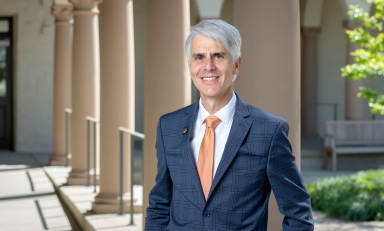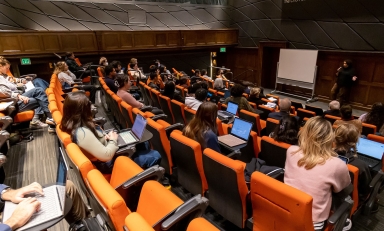
Occidental’s engineering-as-art solar array helped the College avoid $282,000 in electrical bills in its second year of operation -- an impressive increase of 17 percent over the previous 12 months.
Oxy’s 1-megawatt ground-mounted solar array is one of the largest of its kind in Los Angeles. Since going online in March 2013, it has generated a total of 3.67 gigawatt hours of electricity, accounting for 12.3 percent of the College's total electrical usage.
"Put another way, the energy produced by our array last year was enough to power 339 of our neighbors’ houses for two years," says physics Professor Daniel Snowden-Ifft, who proposed the idea of the array and was instrumental in getting the project built. "That’s a lot of energy."
What makes the array unique is that two-thirds of its 4,886 panels are installed on a southwest-facing campus hillside just 2-3 feet above the ground. Art faculty collaborated with a local design firm to create a curving design that hugs the contours of the slope, based on a mathematical expression known as a hysteresis loop.
"Our project represents a new paradigm for arrays as architectural objects that, like buildings, are expected to contribute aesthetically to their environment," says President Jonathan Veitch.
At the same time it is generating green energy, Occidental is working to reduce its overall demand for electricity. Largely hidden from view, a series of upcoming projects is aimed at improving campus services even as they reduce utility use. They include:
- The recently completed revamping of the College’s central chiller plant. Over the next few months, this will expand and improve Oxy’s ability to regulate building temperatures even as new, more efficient equipment reduces water and power use.
- A mechanical and plumbing retrofit for Norris Chemistry. The existing steam heating system serving Norris laboratories will be replaced with a 99 percent efficient hydronic boiler that relies on hot water.
- An examination of the College’s entire aging steam distribution system to determine whether it should be repaired or rebuilt, or replaced with hydronic boilers.
- A plan to better coordinate heating and cooling controls in science buildings so that ventilation and safety systems, including venting hoods, are working in concert and not at cross purposes.
- A plan to improve outdoor lighting with LED fixtures that provide better coverage and improve safety while reducing power usage.
"We’ve already plucked much of the low-hanging fruit – using LED lights inside buildings, installing variable-speed motors, upgrading building controls, and installing meters on individual buildings to give us better data," said Michelle McFadden Hill, assistant director of energy services. "None of these steps are glamorous and few are even visible, but taken together they will have a major impact on campus sustainability."



